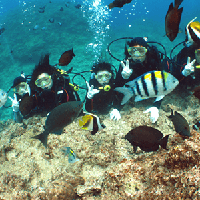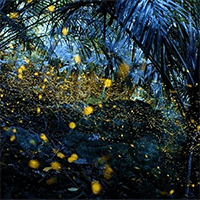List of Ou Island
- Age 6~Age 100
- 3~4 hours
- 09:00 / 14:00
"Ko-Iga" is the highest peak of pottery in history, known as "exceptional beauty" in the world of tea ceremony, mainly during the Sengoku period, when Sen no Rikyu, Oda Nobunaga, and Toyotomi Hideyoshi were active, and the Azuchi-Momoyama period. Experience Awaji Iga making, a reproduction of the Ko-Iga making used in tea ceremony at that time, with one-on-one guidance from a craftsman who hand-made the largest six-tiered climbing kiln in Japan. Ko-Iga is fired at the world's highest firing temperature of 1400℃ for several days, which is unparalleled in the world, so the shape is distorted and sometimes it breaks when firewood is repeatedly hit against it, but the absolute presence and scenery that surpasses this are known as exceptional beauty. (*250℃-450℃ in a bonfire, 1500℃ in a blast furnace) Awaji Iga aims to revive Ko-Iga and values the invisible process and value, so it does not use modern tools such as burners and thermometers, or glazes that glassify the surface. During the Sengoku period, wars were taking place all over Japan, but no one really wanted war, and tea ceremonies served as a place for secret talks to avoid war. It is said that Ko-Iga was used as a special tool to hold a special tea ceremony, which could avoid war if successful, or lead to war if unsuccessful. At Tsurugi Kiln, you can experience the revival of Ko-Iga, which was used in tea ceremonies that determined history and people's lives and deaths, and the making of Awaji Iga pottery. *The actual experience is limited to the forming process. During the four days and nights of the kiln firing in February, you can visit the impressive site at any time. Please visit Awaji Island three times to enjoy the forming process, the kiln firing in February, and the collection after April. ■Itinerary 1. Decide what to make 2. Knead the clay 3. Shape, make strings, hand-form, and make balls *The actual experience is limited to the forming process. During the kiln firing in February, you can see the items you made yourself. *As the items are fired once a year during the kiln firing in February, they will be handed over after spring.
- Age 10~Age 100
- Within 1 hour
You can experience making incense sticks by choosing the scent and shape using rare sandalwood. After molding, dry it at home and light it or enjoy it as a room fragrance. The northern part of Awaji Island, where Parche Fragrance House is located, is known as a town of fragrance because of the concentration of incense manufacturers. You can experience making incense sticks using the rare sandalwood that is unique to the town of fragrance. It is a time to learn about the ingredients of incense, experience the manufacturing process, and learn about incense. Take it home, dry it, light it, and enjoy it as a room fragrance! The experience schedule is as follows. ● Meeting place / reception Fragrance House (please come to the photo) ● Incense making experience (50 minutes) ① Explanation of the experience ② Choose one of four types of fragrance. ③ Put the ingredients in a mortar and knead it with a pestle until it becomes clay-like. ④ Use a stick to stretch it to a uniform thickness. ⑤ Cut it into your desired shape. ⑥Arrange the removed incense sticks on the cardboard, stack the cardboard boxes, secure them with rubber bands, and put them in a bag to take home. ⑥Finished! Once you get home, let the incense dry (for about 2-3 days).
- Age 6~Age 100
- 2~3 hours
- 11:00 / 11:30 / 12:00 / 12:30 / 13:00 / 13:30 / 18:00
Kairi is a renovated old house located in the inland scenery of Awaji Island, where the traditional scenery remains. You can enjoy dishes that are carefully prepared one by one using local ingredients, tableware, and space that the owner is particular about, and the scenery will relax your mind. The owner is particular about using seasonal ingredients that correspond to the seasons of Awaji Island! As much as possible, he uses locally grown and locally harvested ingredients. He takes the time and effort to carefully arrange each dish with delicate care, using crops that have been grown with love and seafood that have been harvested with great effort and hard work. If he cannot get them, he himself goes to pick wild vegetables and makes tea. The owner's attention to detail can be felt not only in the ingredients, but also in the tableware, forks, knives, chopsticks, temperature and space to suit the dishes served. Also, Kairi does not have a set menu. He thinks about the local ingredients that are available at the time, so the menu is handwritten by the owner and posted at the entrance of Kairi every day. Looking out from the entrance, you can see the unspoiled scenery of the past. The interior of this old-fashioned house blends in with the scenery, and you can enjoy a relaxing time in a space that exudes the beauty of traditional Japan, with an irori hearth, a veranda, nostalgic yet beautiful patterned glass windows, and a transom at the top of the room that acts as a partition while letting in air and light.
最近チェックしたプラン
Please wait a moment
![[Hyogo, Minami Awaji] Experience making "Awaji Iga", a reproduction of "Ko-Iga", the highest peak of pottery in history, which was known as "exceptional beauty" in the world of tea ceremony mainly during the Sengoku period!の画像](https://img.activityjapan.com/10/58639/10000005863901_1Gz5AIDf_3.webp?version=1744257065)
![[Hyogo/Awaji] No.1 share of domestic incense! Experience making incense while learning about ingredients and manufacturing processes at the incense town theme park. Make your own scent and shape to suit your taste.の画像](https://img.activityjapan.com/10/58590/10000005859001_1Gz5AIDf_3.webp?version=1744001282)
![[Awaji, Hyogo] Heartwarming local cuisine made with ingredients from the sea and mountains of Awaji Island. Enjoy a happy time in the countryside, sitting around the hearth of an old house on the veranda and looking out at the garden and rice terraces.の画像](https://img.activityjapan.com/10/58589/10000005858901_1Gz5AIDf_3.png?version=1744000142)







